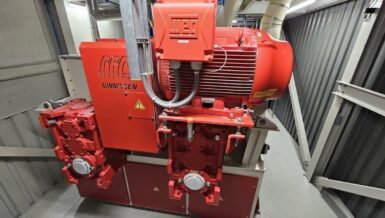It’s not uncommon for me to get a call from a customer with a mixer that is not performing up to their expectation regarding quality and batch mix times. When I start asking questions, the truth of the matter is revealed. An operator will often see the mixer has “more room” to fill and decide to increase the batch size without understanding the sweet spot of the mixer’s performance. The mixer is commonly overfilled.
The mixer design for volume is based on the required batch size and the density of the materials to be mixed. Once those parameters are established, the volume required is set, and the mixer model is selected.
Fill Level
First, proper mixing requires the agitator to “breakthrough” the top of the bed of material in the mixer. While the mixer is static (not under power/ not running), a minimum of 6-8″ of the agitator should be above the bed of material. This fill level will ensure the agitator will leverage the design to draw down the material from the top and convey it end to end. Under power (running), the agitator will change the profile of the materials being mixed. As the agitator draws the material downward (the low side) on one side, the agitator rotation will pull the material up on the other side. This is called the high side. This dynamic is important and leads to the second key point.
Location
Secondly, when adding minors or micro-ingredients to the batch to be mixed, location, location, and location is important. If minors or micros were added to a mixer over the recommended fill level the likelihood of these added ingredients being thoroughly mixed will be compromised. The overall batch quality and mix time will suffer in this case. The best practice is to add these ingredients to an area in the middle of the mixer instead of along the edge or a corner of the mixer. The location of the additions is compounded by improper or overfilling the mixer. Adding the minors and micros in a center location will give the mixer the best opportunity to provide the best quality and performance for the mixed batch.
Sequence
Finally, the sequence of addition matters. Major on the majors. Your major ingredients should be your first add. Minors and micros (any liquids if required) should follow in that order. There is a reason for this. Micros, if added first, can get lost in the corners or discharge dead space (if present). The sequencing of the additions is compounded by improper or overfilling the mixer. Proper sequencing will benefit your production quality and performance of the mixed batch.
Establishing a mixing protocol, including maximum fill levels, location of additions, and sequencing, will set guidelines for successful batch mixing.













